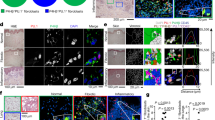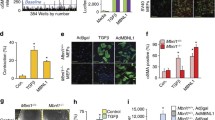Abstract
Wnt proteins elevate expression of the CCN family. For example, Wnt10b induces the fibrogenic pro-adhesive molecule connective tissue growth factor (CTGF, CCN2) in NIH 3T3 fibroblasts. Wnt10b activates the CCN2 minimal promoter. In this report, we map the Wnt10b response element in the CCN2 minimal promoter to the previously identified Smad response element. These results suggest that Wnts may cross-talk with the Smad signaling pathway to induce fibrotic responses in fibroblasts.
Similar content being viewed by others
Avoid common mistakes on your manuscript.
Introduction
Wnts (such as Wnt10b) stimulate numerous intracellular signal transduction cascades, including the canonical β-catenin pathway (Kühl et al. 2000). In the absence of Wnts, β-catenin is degraded whereas the presence of Wnts results in β-catenin stabilization and nuclear localization (Willert and Jones 2006). Wnts play an essential role in brain, limb, mammary, skin, and cardiovascular and lung development (Logan and Nusse 2004). It has been suggested that fibroblasts isolated from fibrotic lesions of scleroderma patients possess a so-called ‘Wnt-signature’ (Gardner et al. 2006). However, the application of Wnts to fibroblasts results not in the direct activation of collagen mRNA expression, complete fibrogenic or tissue repair program, but rather is likely to do so indirectly through the induction of genes thought to influence collagen production, such as members of the CCN family of proteins [including CTGF (CCN2) and cyr61 (CCN1)], endothelin-1 and transforming growth factor β (Chen et al. 2007).
Previously, we had shown that Wnt10b activates CCN2 expression at least in part through elements in the CCN2 promoter (Chen et al. 2007). In this report, we use promoter deletion and mutation constructs to map the Wnt response element. Our results give new insights into the role that Wnts may play in fibroblast differentiation.
Materials and methods
Cell culture
NIH 3T3 fibroblasts (ATCC) were cultured in low glucose Dulbecco's modified Eagle's medium (DMEM), 10% calf serum, and antibiotic/antimycotic solution (Invitrogen, Burlington, Ontario) at 37°C, 5% CO2. Conditioned media obtained from cell lines overexpressing Wnt 10b or containing empty expression vector (courtesy Cun-Yu Wang, University of Michigan) was added to DMEM/0.5% calf serum in a 1:1 ratio, as described previously (Chen et al. 2007).
Transfection assays
For transfection assays, cells were plated at a density of 25000 cells/well in a 24 well plate. Cells were allowed to grow for 24 h at 37°C, 5% CO2. Cells were then transfected with polyfect (Qiagen) as described by the manufacturer. Cells were transfected with plasmids containing a CCN2 promoter fused to a secreted alkaline phosphatase (SEAP) reporter gene. Cells were transfected with 1 μg of CCN2-SEAP constructs that contained the −805 to +17 region of the CCN2 promoter (Abraham et al. 2000; Holmes et al. 2001). Cells were cultured for 16 h in serum-free media then treated with or without Wnt10b for 24 h. To control for transfection efficiency cells were cotransfected with 0.5 μg of a cytomegalovirus (CMV) promoter– β-galactosidase (β-gal) reporter gene (Clontech, Palo Alto, CA, USA) construct. Promoter assays were performed with a Phospha-Light kit (Applied Biosystems, Foster City, CA, USA) according to manufacturer’s protocol and SEAP reporter expression was adjusted for differences in β-galactosidase expression as determined by a Galacto-star kit (Applied Biosystems) according to manufacturer’s protocol. Data was expressed as average values +/− standard deviation of at least 3 replicates and at least two independent trials. Measurement of SEAP levels were obtained from an LMax II 384 luminometer (Molecular Devices, Sunnyvale CA, USA) and SoftMax Pro 4.7.1 (Molecular Devices, Sunnyvale CA, USA). Levels were measured in relative light units and were standardized to control values from β-gal. Statistical tests were done using one-way ANOVA and Tukey’s post-hoc test on GraphPad.
Results
Wnt10b induces the CCN2 promoter (Chen et al. 2007). To elucidate the elements in the CCN2 promoter mediating this response, NIH 3T3 fibroblasts were transfected with a CCN2 promoter/reporter construct bearing nucleotides −805 and +17 of the promoter and, confirming previous data, Wnt10b induced the CCN2 promoter (Fig. 1). We found that removal of the segment of the CCN2 promoter residing between −805 and −166 removed responsiveness to Wnt10b (Fig. 1). Residing within this element is a functional Smad recognition motif (Holmes et al. 2001). Mutation of the Smad element abolished the ability of the CCN2 promoter to respond to Wnt10b (Fig. 1). Thus Wnt10b activates the CCN2 promoter, likely through Smads.
Wnt 10b induce the CCN2 promoter in fibroblasts via the Smad response element. NIH 3T3 fibroblasts were transfected with a CCN2 promoter/SEAP reporter construct, which contains the region spanning from −805 to +17 of the CCN2 promoter (Abraham et al. 2000). CTGF promoter mutation and deletion constructs were also employed, as indicated (Abraham et al. 2000; Holmes et al. 2001). After a serum starvation step, cells were treated with or without conditioned media from cells stably transfected with empty expression vector or expression vector encoding Wnt 10b (24 hours). Experiments were performed thrice. A representative experiment is shown (N = 6, average +/− standard deviation is shown). Fold change in response to Wnt 10b or vector alone is shown. Significance is indicated by *
Discussion
Canonical, but not non-canonical, Wnts activate the CCN2 promoter (Chen et al. 2007). In the case of Wnt10b, elements within the minimal −805 to +17 CCN2 promoter mediate this induction. In this report, we map the Wnt10b response element to the previously identified Smad response element of the CCN2 promoter (Holmes et al. 2001).
It is now recognized that Wnts crosstalk with the TGFβ signaling pathway (Guo and Wang 2009). For example, although the promoter of gastrin contains both Smad and Lef/Tcf binding sites, either site alone can recruit Smads and β-catenin, which act as mutual co-factors facilitated by the p300 co-activator protein (Lei et al. 2004). Moreover, Smad3-β-catenin cross-talk has been observed in human mesenchymal stem cells (hMSCs). In particular, TGF-β and Wnt cooperatively stimulate the proliferation of hMSCs and inhibit their differentiation into the osteocytic and adipocytic lineages, thereby supporting hMSC self-renewal (Jian et al. 2006). In addition, Smad3 and β-catenin co-regulate a cohort of genes in these cells that are otherwise not known to be TGF-β or Wnt targets, such as the Src family tyrosine kinase BLK (Jian et al. 2006). Finally, myostatin-inhibited adipogenesis in human bone marrow-derived mesenchymal stem cells are mediated, in part, by activation of Smad3 and cross-communication of the TGFβ/Smad signal to Wnt/β-catenin/TCF4 pathway, with Smad3 directly interacting with β-catenin (Guo et al. 2008). Our results showing that the Wnt10b activates the CCN2 promoter via the Smad response element are consistent with these data.
Collectively, our results emphasize that cross-talk exists between the Wnt and TGFβ pathway and that this interaction may contribute to elevated gene expression in tissue repair and fibrosis.
References
Abraham DJ, Shiwen X, Black CM, Sa S, Xu Y, Leask A (2000) Tumor necrosis factor alpha suppresses the induction of connective tissue growth factor by transforming growth factor-beta in normal and scleroderma fibroblasts. J Biol Chem 275:15220–15225. doi:10.1074/jbc.275.20.15220
Chen S, McLean S, Carter DE, Leask A (2007) The gene expression profile induced by Wnt 3a in NIH 3T3 fibroblasts. J Cell Commun Signal 1:175–183. doi:10.1007/s12079-007-0015-x
Gardner H, Shearstone JR, Bandaru R, Crowell T, Lynes M, Trojanowska M, Pannu J, Smith E, Jablonska S, Blaszczyk M, Tan FK, Mayes MD (2006) Gene profiling of scleroderma skin reveals robust signatures of disease that are imperfectly reflected in the transcript profiles of explanted fibroblasts. Arthritis Rheum 54:1961–1973. doi:10.1002/art.21894
Guo X, Wang XF (2009) Signaling cross-talk between TGF-beta/BMP and other pathways. Cell Res 19:71. doi:10.1038/cr.2008.302
Guo W, Flanagan J, Jasuja R, Kirkland J, Jiang L, Bhasin S (2008) The effects of myostatin on adipogenic differentiation of human bone marrow-derived mesenchymal stem cells are mediated through cross-communication between Smad3 and Wnt/beta-catenin signaling pathways. J Biol Chem 283:9136–9145. doi:10.1074/jbc.M708968200
Holmes A, Abraham DJ, Sa S, Shiwen X, Black CM, Leask A (2001) CTGF and SMADs, maintenance of scleroderma phenotype is independent of SMAD signaling. J Biol Chem 276:10594–10601. doi:10.1074/jbc.M010149200
Jian H, Shen X, Liu I, Semenov M, He X, Wang XF (2006) Smad3-dependent nuclear translocation of beta-catenin is required for TGF-beta1-induced proliferation of bone marrow-derived adult human mesenchymal stem cells. Genes Dev 20:666–674. doi:10.1101/gad.1388806
Kühl M, Sheldahl LC, Park M, Miller JR, Moon RT (2000) The Wnt/Ca2 + pathway: a new vertebrate Wnt signaling pathway takes shape. Trends Genet 16:279–283. doi:10.1016/S0168-9525(00)02028-X
Lei S, Dubeykovskiy A, Chakladar A, Wojtukiewicz L, Wang TC (2004) The murine gastrin promoter is synergistically activated by transforming growth factor-{beta}/Smad and Wnt signaling pathways. J Biol Chem 279:42492–42502. doi:10.1074/jbc.M404025200
Logan CY, Nusse R (2004) The Wnt signaling pathway in development and disease. Annu Rev Cell Dev Biol 20:781–810. doi:10.1146/annurev.cellbio.20.010403.113126
Willert K, Jones KA (2006) Wnt signaling: is the party in the nucleus? Genes Dev 20:1394–1404. doi:10.1101/gad.1424006
Acknowledgements
Our work is supported by grants from the Canadian Institutes of Health Research (CIHR) and the Canadian Foundation for Innovation. A.L is a New Investigator of the Arthritis Society (Scleroderma Society of Ontario) and a recipient of an Early Researcher Award.
Open Access
This article is distributed under the terms of the Creative Commons Attribution Noncommercial License which permits any noncommercial use, distribution, and reproduction in any medium, provided the original author(s) and source are credited.
Author information
Authors and Affiliations
Corresponding author
Rights and permissions
Open Access This is an open access article distributed under the terms of the Creative Commons Attribution Noncommercial License (https://creativecommons.org/licenses/by-nc/2.0), which permits any noncommercial use, distribution, and reproduction in any medium, provided the original author(s) and source are credited.
About this article
Cite this article
Chen, S., Leask, A. Wnt 10b activates the CCN2 promoter in NIH 3T3 fibroblasts through the Smad response element. J. Cell Commun. Signal. 3, 57–59 (2009). https://doi.org/10.1007/s12079-009-0049-3
Received:
Accepted:
Published:
Issue Date:
DOI: https://doi.org/10.1007/s12079-009-0049-3





